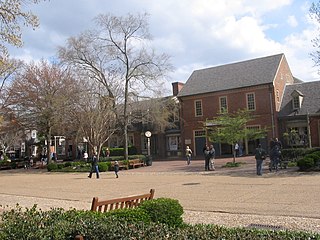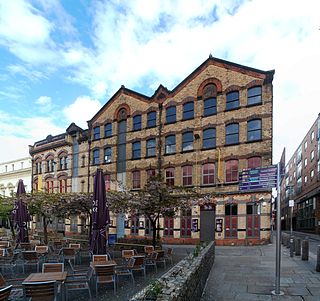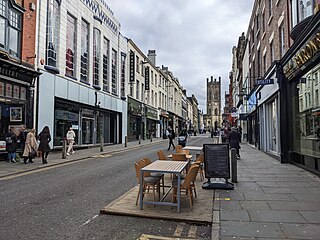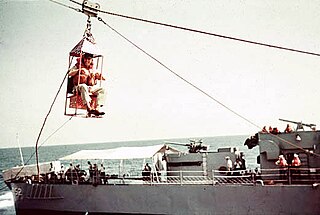
Shanklin is a seaside resort town and civil parish on the Isle of Wight, England, located on Sandown Bay. Shanklin is the southernmost of three settlements which occupy the bay, and is close to Lake Sandown. The sandy beach, its Old Village and a wooded ravine, Shanklin Chine, are its main attractions. The esplanade along the beach is occupied by hotels and restaurants for the most part, and is one of the most tourist-oriented parts of the town. The other is the Old Village, at the top of Shanklin Chine. Together with Lake and Sandown to the north, Shanklin forms a built up area of around 25,000 inhabitants, Shanklin alone contributing around 7,200 of this.
This glossary of nautical terms is an alphabetical listing of terms and expressions connected with ships, shipping, seamanship and navigation on water. Some remain current, while many date from the 17th to 19th centuries. The word nautical derives from the Latin nauticus, from Greek nautikos, from nautēs: "sailor", from naus: "ship".

St Luke's Church, more commonly known by locals as the bombed-out church, is a former Anglican parish church in Liverpool, England. It stands on the corner of Berry Street and Leece Street, at the top of Bold Street.

Liverpool ONE is a shopping, residential, and leisure complex in Liverpool, England. The project involved the redevelopment of 42 acres of land in the city centre. It is a retail-led development anchored by the department store John Lewis. Debenhams had previously been an anchor tenant until the closure of its Liverpool One store in March 2021, with Marks & Spencer taking its place in mid-2023. Additional elements include leisure facilities, apartments, offices, public open spaces, restaurants, and transport improvements. The completion of Liverpool ONE significantly boosted the local economy, while lifting Liverpool into the top five most popular retail destinations in the UK.

The Lyceum is a Neoclassical Grade II* listed building located on Bold Street, Liverpool. It was constructed in 1802 as a news-room and England's first subscription library (1758–1942) and later became a gentleman's club. After the club relocated in 1952 the building was left unoccupied for many years, eventually falling into a state of disrepair. Calls were made for its demolition in the late 1970s, sparking a campaign to save the building. It reopened as a post office, and then a branch of the Co-operative Bank. As of May 2024, its tenants are a Chinese restaurant and a miniature golf and bar venue called One Below.

Wellington's Column, or the Waterloo Memorial, is a monument to the Duke of Wellington standing on the corner of William Brown Street and Lime Street, Liverpool, Merseyside, England. It is recorded in the National Heritage List for England as a designated Grade II* listed building.

Sheffield City Centre is a district of the City of Sheffield and is covered partly by the City ward of the City of Sheffield. It includes the area that is within a radius of roughly 0.75 miles (1.2 km) of Sheffield Cathedral and is encircled by the Inner Ring Road, a circular route started in the late 1960s and completed in 2007. As well as the cathedral, buildings in the city centre include the Grade I listed Town Hall, the City Hall and the Winter Gardens. Several areas of the city centre have been designated as quarters. It is home to the city's major business, transport, leisure and cultural attractions.

Gardiner Street is a long Georgian street in Dublin, Ireland. It stretches from the River Liffey at its southern end via Mountjoy Square to Dorset Street at its northern end. The Custom House terminates the vista at the southern end, and the street is divided into Gardiner Street Upper, Gardiner Street Middle and Gardiner Street Lower.

Merchants Square is a 20th-century interpretation of an 18th-century-style retail village in Colonial Williamsburg, Virginia, United States. It is listed on the National Register of Historic Places.

The architecture of Liverpool is rooted in the city's development into a major port of the British Empire. It encompasses a variety of architectural styles of the past 300 years, while next to nothing remains of its medieval structures which would have dated back as far as the 13th century. Erected 1716–18, Bluecoat Chambers is supposed to be the oldest surviving building in central Liverpool.

Marylebone is an area in London, England and is located in the City of Westminster. It is in Central London and part of the West End. Oxford Street forms its southern boundary.

Concert Square is a square located between Wood Street and Fleet Street in the RopeWalks area of Liverpool City Centre, England. The square and the immediate surrounding area is often referred to as the heart of Liverpool's nightlife, due to the area being populated with some of the best known nightclubs and bars in the city, and indeed the North West of England. The square has often been a centre for football fans' celebration. A 2019 survey of university students in the UK found two Liverpool universities ranked amongst the top 5 for nightlife, with Concert Square being cited as a factor.

Clayton Square Shopping Centre is an inner-city shopping centre located in Liverpool, England. It is in close proximity to Liverpool Lime Street and Liverpool Central railway stations. It is the city's fourth largest shopping centre behind Liverpool One, St. John's Shopping Centre and Metquarter. Clayton Square sees tough competition from the likes of Liverpool One, St.Johns, Metquarter, Church Street, Lord Street and Bold Street.
Glasgow City Centre is the central business district of Glasgow, Scotland. Is bounded by Saltmarket, High Street and Castle Street to the east, The River Clyde to the south and the M8 motorway to its west and north. Glasgow City Centre is composed of the areas of Garnethill, Blythswood Hill and Merchant City as well as parts of Cowcaddens, Townhead, Anderston and Calton.

Liverpool city centre is the commercial, cultural, financial and historical centre of Liverpool and the Liverpool City Region, England. Different definitions of the city centre exist for urban planning and local government, however, the border of Liverpool city centre is broadly marked by the inner city districts of Vauxhall, Everton, Edge Hill, Kensington and Toxteth.

RopeWalks is a district of Liverpool city centre bounded by Hanover Street to the north-west, Lydia Ann Street to the west, Roscoe Street to the east and Back Bold Street to north-east.
Retail & Leisure BID is a business improvement district (BID) that represents over 650 businesses in the retail and leisure heart of Liverpool's city centre, covering a total area of 49 acres and including 61 streets, such as Bold Street, Church Street, Lord Street, the Cavern Quarter, Whitechapel, Williamson Square, Queen Square, Ranelagh Street and all inter-connecting streets. The BID aims to enhance the public services of the local authority by raising a 1.2% levy on its members' annual business rates. This five-year program is intended to provide a safe, clean, attractive, and well-promoted trading area within Liverpool's city centre.

Middlesbrough Town Hall is a municipal facility located in Albert Road in Middlesbrough, North Yorkshire, England. It is a Grade II* listed building.

A jackstay is a cable or bar between two points to support and guide a load between those points, or as an anchor to attach something to be constrained along that line. The term is mostly used in a marine context and originated on sailing ships. Note the use of "stay" implies load bearing working rigging. In diving it is also a line to guide the movements of a diver between the endpoints.
This glossary of nautical terms is an alphabetical listing of terms and expressions connected with ships, shipping, seamanship and navigation on water. Some remain current, while many date from the 17th to 19th centuries. The word nautical derives from the Latin nauticus, from Greek nautikos, from nautēs: "sailor", from naus: "ship".





















